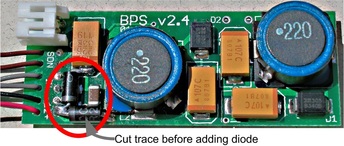Question
I'm having trouble understanding the battery charging operation. It seems like I read somewhere that any track voltage over 4 volts charges the battery. Another place that the track voltage must be between 12 and 13 volts.
ResponseTwo diodes have been added to the BPS circuit board and all BPS deliveries now include this modification. This allows rectified BPS input to flow through a diode to the output. The second diode connects battery power to the output. |
Explanation
As originally designed, BPS used track power only to charge the battery and loco power was supplied
exclusively from the battery.
As modified, the diodes provide rectified input OR battery power (12 volts from the step-up converter) to operate the loco, depending which is the higher voltage. When rectified input exceeds 12.5 volts, the battery makes no contribution to BPS output, but is instantaneously available as backup power for any drop in track voltage. The only reason for choosing 13 volts as an operational limit for track voltage is to avoid loco speed changes as power supply switches from track to battery power. The maximum upper limit for track voltage is 16 volts (rectified).
When track voltage drops below 10 volts (approx.), all loco power is supplied by the battery.
Battery charging begins whenever track voltage (DC) exceeds 4.5 volts and the charge rate (450 mA) is independent of track voltage. Since this charging input is not sufficient to power a loco under load, the battery will, on average (depending on loco load), be discharging when operating with track voltage below 10 volts. When track voltage exceeds 12.5 volts all of the charging input is used to recharge the battery. Since this is true, irrespective of whether or not the decoder is actually doing anything, 12.5 volts maximizes the energy being stored in the battery. It's the fastest way to recharge.
exclusively from the battery.
As modified, the diodes provide rectified input OR battery power (12 volts from the step-up converter) to operate the loco, depending which is the higher voltage. When rectified input exceeds 12.5 volts, the battery makes no contribution to BPS output, but is instantaneously available as backup power for any drop in track voltage. The only reason for choosing 13 volts as an operational limit for track voltage is to avoid loco speed changes as power supply switches from track to battery power. The maximum upper limit for track voltage is 16 volts (rectified).
When track voltage drops below 10 volts (approx.), all loco power is supplied by the battery.
Battery charging begins whenever track voltage (DC) exceeds 4.5 volts and the charge rate (450 mA) is independent of track voltage. Since this charging input is not sufficient to power a loco under load, the battery will, on average (depending on loco load), be discharging when operating with track voltage below 10 volts. When track voltage exceeds 12.5 volts all of the charging input is used to recharge the battery. Since this is true, irrespective of whether or not the decoder is actually doing anything, 12.5 volts maximizes the energy being stored in the battery. It's the fastest way to recharge.
